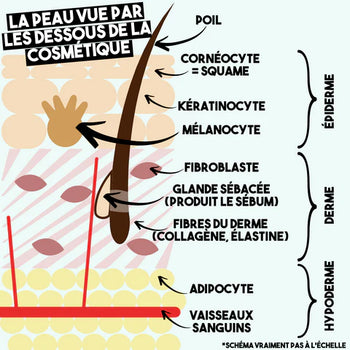Podcast: Episode 27, 10 solutions to limit photoaging
Listen to the audio episode on the 10 solutions to limit photoaging
- Available on: Episode 27: 10 solutions to limit photoaging
- Also available on Spotify , Apple Podcast and Google Podcast
PHOTOAGEING
The sun accelerates the aging of the skin: wrinkles, fine lines, loss of firmness then appear before their time. This is called photoaging. According to certain studies ¹ , the sun is responsible for 90% of the visible signs of aging... so how do we prevent rather than correct? How does our skin protect itself? What should she protect herself against?
¹ we can make reservations about this value of 90% but the sun represents an important part of skin aging
THE DIFFERENT RAYS OF THE SUN
The sun emits different types of rays which are classified according to their wavelengths. Wavelength is a physical quantity that is measured in nanometers (nm). Here are the categories of the sun's waves, ordered from shortest to longest wavelength:
- gamma rays
- x-rays
- ultraviolet rays (UV)
- visible light
- infrared rays (IR)
- microwaves
- radio waves

Fig.1: The rays of the sun
The spectrum of visible light breaks down into an infinity of colored rays, all having only one color. The smallest color is violet, then it tends towards blues, greens, yellows, oranges and the largest is the color red. Ultraviolet rays are therefore rays smaller than the color violet (the shortest wavelength of visible light) and infrared rays are rays larger than red light (the longest wavelength of visible light wave).
THE DANGERS OF ULTRA VIOLET UV RAYS
The rays that interest us the most in cosmetics are UV rays because they are responsible for the vast majority of the harmful effects of the sun.
They can be sub-divided into three categories:
- UV𝐂 (100-290 nm): These small rays can cause big damage, but they are stopped by the ozone layer.
- UV𝐁 (280-320 nm): they are responsible for sunburn (𝐁 like burning)
- UV𝐀 (320-440 nm): they are responsible for photo-aging (𝐀 as age)
🖇 Go listen to episode 14 on skin aging for more details on the mechanisms of action of UVB and UVA, the formation of free radicals, etc.
UVS AND SUNBURN
UVB rays are 90% stopped by the ozone layer . The rest of the UVB that arrives at the surface of the earth, and therefore on our skin, are mainly stopped by the first layer of the skin, the epidermis. Only 10% of the rays that reach the skin reach the dermis (🖇see episode 9 for more details on the dermis). UVB is mostly stopped by glass , so we are mostly protected from UVB inside, through the windows.
UVB rays have a shorter wavelength than UVA rays, but they have more energy, so they can do more damage. By reaching skin cells, they can damage their membranes, causing the cell to die or their DNA, leading to mutations that can become cancerous.
It is also the type of ray that is involved in the production of vitamin D. They are also responsible for sunburn .
💡The mnemonic to remember UVB damage: UV B , B as burn.
The amount of UVB that we receive is stronger during the summer and when the sun is at its highest. You can check the UV Index on your phone's weather app.

Fig. 2: The weather application and the UV index of the day
UVA AND PHOTOAGEING
UVA rays, on the other hand, penetrate more deeply into the ozone layer with 95% of the latter reaching the Earth's surface.
They have a longer wavelength, they penetrate further into the skin going to the dermis. They therefore do damage to the dermis , which is the elastic tissue. They thus accelerate the appearance of the signs of aging . They form free radicals that have lone electrons, making them extremely reactive with their surroundings. They will therefore react and damage the cells of your surrounding skin, which causes the appearance of wrinkles, fine lines and other signs of aging.
Like UVB, their amount depends on the time of day and the season. However, the variation is much less significant than for UVB. It is therefore all the more interesting to protect yourself from UVA rays during your daily life, even if you are not exposing yourself specifically.
💡 The mnemonic to remember UVA damage: UVA, A for Age.
CAN THE SKIN NATURALLY PROTECT ITSELF FROM THE SUN?
Our skin is naturally made up to partially protect itself from UV rays. In particular thanks to melanin , the pigment of the skin. Melanin is produced and transported by melanosomes. Melanosomes are capsules that transport melanin to different skin cells to protect them from the sun. Melanosomes are produced by melanocytes which are star-shaped or octopus-shaped skin cells, depending on the imagination.

Fig. 3: Illustration of skin structure (not to scale)
There are different types of melanin (eumelanin, pheomelanin, etc.) and it is the ratio, quantity and size of these different melanins that differs from one individual to another. These differences are characterized by skin phototype .
WHAT IS SKIN PHOTOTYPE?
 Fig. 4: Illustration of phototypes
|
The phototype is a classification of skin colors and their sensitivity to the sun ranging from 1 to 6. For example, a white skin that burns in the sun is a phototype I while a black skin that never burns in the sun is a phototype VI. |
The difference in natural protection against the sun between a phototype I and VI can be very large. A VI phototype can blush up to 60 times more slowly than a I phototype . If phototype I blushes in 5 minutes in the sun then phototype VI would blush in 300 minutes, or 5 hours of exposure!
CAN THE SKIN IMPROVE ITS RESISTANCE TO THE SUN?
The skin adapts to better protect itself from the sun. After being exposed to the sun:
- the layer of dead skin cells thickens to filter out UV rays a little
- the skin begins to produce more pigments to better protect itself: the skin tans
Tanning can therefore be seen as an adaptation to stress . In some cases, tanning a very white skin can then allow it to stay 10 times longer in the sun before blushing. But don't get me wrong, if there has been a tan, it means that the skin has been stressed by the sun and has experienced the associated damage.
THE 10 SOLUTIONS TO LIMIT PHOTOAGEING
The natural protection of the skin is not enough to take care of our health, which is why dermatologists² have made a list of tips including the following:
- Avoid the sun between 12 p.m. and 4 p.m. in summer because these are the hours during which UV rays are the most aggressive ⏱
- Prefer morning or late afternoon sun, to benefit from UV filtration by the atmosphere 🏝
- Wear clothes to protect yourself from the sun: wide-brimmed hat, t-shirt, pants 👕
- Don't forget eye protection: cap, sunglasses 🕶
- Regularly apply sunscreen products adapted to your phototype and the sunshine conditions, and renew the application every two hours and after each bath. 🧴
- Dry yourself carefully after each bath because the water droplets have a reflective effect that promotes sunburn and reduces the effectiveness of sunscreen products. 💧
- Do not expose yourself after applying perfume or when taking certain photosensitizing drugs, or using vitamin A (retinol) cosmetics 🌹
- Prefer shade ⛱
- Do not expose your baby under 3 years old 👶
- Beware of situations that seem less aggressive: wind, cloud, snow on the ground,... The sun wreaks havoc in summer ❄️
Ratings
¹ RAMOS-E-SILVA M., et al. Anti-aging cosmetics: Facts and controversies . Clinics in Dermatology. 2013. Available at: https://www.academia.edu/download/55674134/Anti-aging_cosmetics_facts_and_controversies.pdf
² SCHMUTZ JL. The sun and the skin . Dermatology info. 2019. Available at: https://dermato-info.fr/fr/les-conseils-dermato_tutos-peau/le-soleil-et-la-peau
Did you like this article? 📌 Pin it on Pinterest to find it later!
 |
 |
 |









Leave a comment